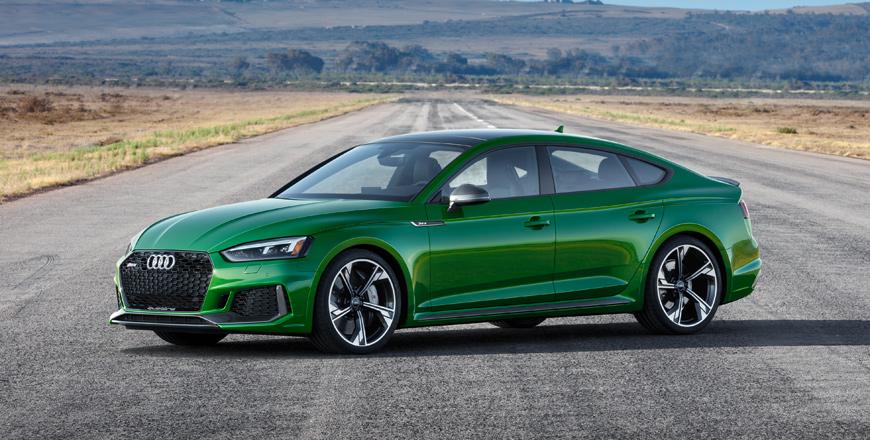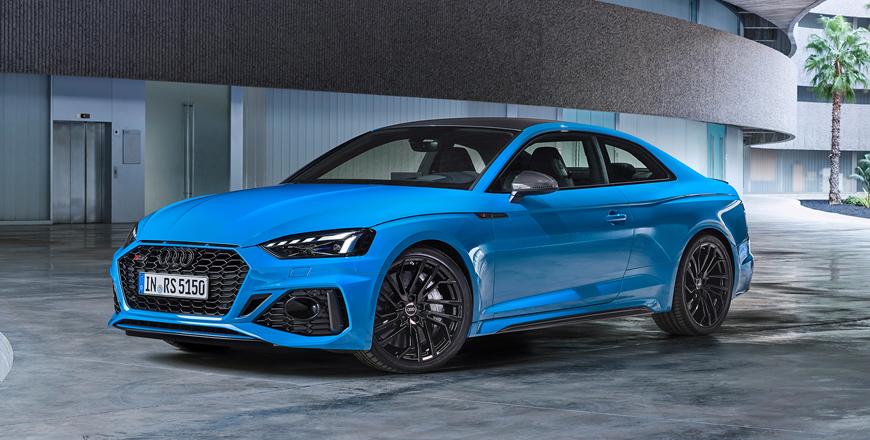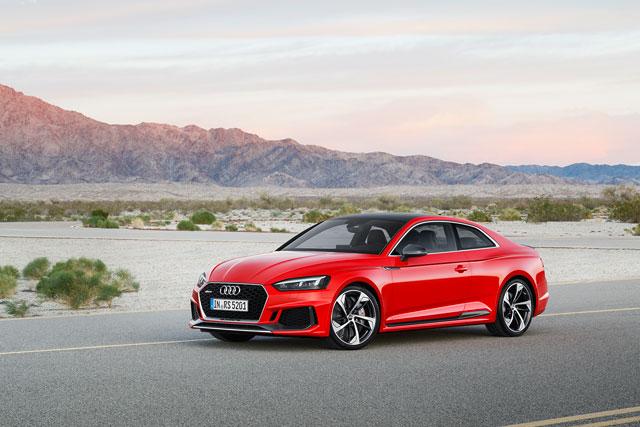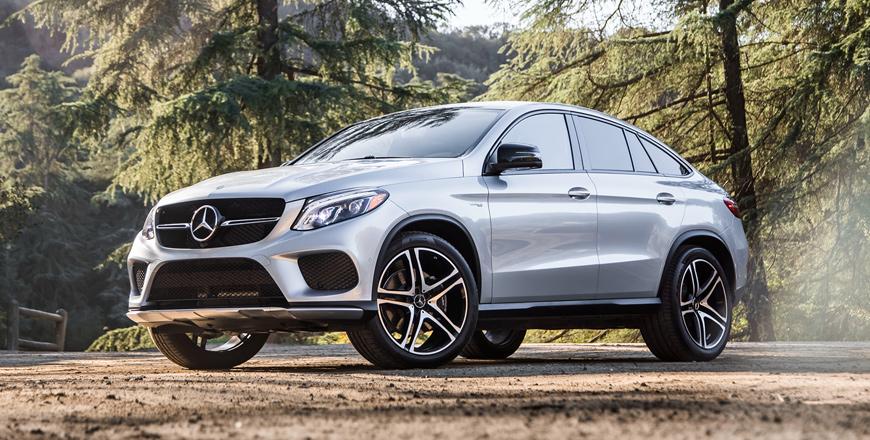You are here
Audi RS5 Sportback: Between style and sensibility
By Ghaith Madadha - Mar 16,2020 - Last updated at Mar 16,2020

Photo courtesy of Audi
Launched last year, the Audi RS5 Sportback is an intersection between the descendants of two of Ingolstadt manufacturer’s most iconic cars, the 1980-91 Quattro and 1994-95 RS2 Avant, and sits somewhere between the two-door RS5 Coupe and the more practical estate-body RS4 Avant. Sharing the same platform, mechanicals and near identical performance as its mentioned and current stablemates, the RS5 Sportback — with its rakish low-roof design and 5-door liftback body — loses little of the former’s sleek hunkered down style yet gains a modicum of the latter’s versatile space and utility.
Fast five-door liftback
A little longer than its Coupe sibling to accommodate the addition of its rear doors and window panes, the RS5 Sportback is otherwise little altered aesthetically apart from looking slightly stretched at the middle and losing the Coupe’s thick C-pillar, which is a more direct visual link to the original and iconic Quattro. Identical in its moody disposition, the Sportback shares the Coupe’s squinting LED headlights, hungry honeycomb hexagonal grille jutting bumper treatment, sills and surfacing, and carries over the subtle wheel-arch blisters and Coke-bottle like side crease kink at the rear haunches.
Virtually indistinguishable from direct rear view, the RS5 Sportback, however, seems to sit with a visually heavier rear emphasis, while its roofline seems more flowing in its arc, and less chunky than the Coupe. Gaining better rear legroom and slightly improved rear headroom, the Sportback notably trades the Coupe’s traditional boot for a much more practical liftback. With much improved lifting height and boot access, the Sportback’s luggage volume is nominally unchanged at 465-litre, but with rear parcel shelf removed and rear seats folded, it offers significantly better expanded capacity.
User-friendly performance
Downsized from the previous generation RS5’s naturally-aspirated 4.20litre V8, the new RS5 is instead powered by twin turbocharged 2.9-litre V6. It retains a similar power output but makes significant gains in torque output and reduced 9.2l/100km fuel economy. However, its character is a little different. Gone is the outgoing model’s intensely progressive build-up and high strung deliver, replaced by a more explosive mid-range surge. And while its rev limit is lower, the new engine manages to both rev high for a turbo unit, and also benefits from good low-end responsive.
Lurking under its long and muscularly contoured bonnet, the RS5’s mighty twin-turbo V6 engine is mounted low and in-line, just in front of the front axle to help develop Audi’s signature tenacious traction. Mated to a slick and quick 8-speed automatic gearbox, the RS5’s punchy engine sends power through Audi’s hallmark Quattro four-wheel-drive system, which achieves vice-like levels of road-holding for secure, stable and highly exploitable all-weather performance. The RS5’s engine management, throttle, gearbox, steering and optional limited-slip rear differential can also be altered in sharpness, aggression and character through various driving mode combinations.
Quick and committed
Producing 444BHP at 5700-6700rpm and a brutally versatile wave of 442lb/ft torque throughout a broad and accessible 1900-5000rpm band, the RS5 is quick-spooling and nearly lag-free from idling, abundant in mid-range and urgent at top-end. Developing immense traction at launch, the Sportback bullets through 0-100km/h sprint in 3.9-seconds, and can attain 280km/h when optionally de-restricted from 250km/h. Smooth, refined and almost acoustically docile in Comfort mode, the RS5, however, takes on a dual personality and adopts a sharper throttle response, and more viciously vocal, snarling and wailing exhaust characteristic in Dynamic mode.
A highly capable high performance low roof saloon or five-door coupe — depending on one’s perspective — the RS5 is effortlessly rapid and user-friendly, with blistering acceleration, deep mid-range pulling power and a ferocious top-end plateau. Accessible for daily driving, the RS5 is manoeuvrable in town with light Comfort mode steering, settled and stable at speed, and committed through corners and over low traction surfaces. Such are its road-holding and the reassuring manner in which it delivers its considerable performance envelope that one need to push closer to its dynamic to best enjoy it.
Reassuring roadholding
The smallest, lightest and most nimble of Audi’s traditional front inline engine cars next to the RS5 Coupe, the Sportback still has a distinctively different approach to high performance motoring than rear-drive derived rivals. Emphasising grip and traction, the RS5’s now lighter engine and more sophisticated five-link all suspension, however, help make it more eager, crisp, tidy and agile on turn-in than expected for its front-biased weighting. The RS5’s agility is further aided by a slight rear bias to its power distribution, and an optional limited slip differential to vary power distribution at the rear.
User-friendly, comfortable and luxurious inside, the Sportback is thoroughly well equipped with safety, assistance, infotainment and convenience features, and has comfortable, supportive quilted leather seats, terrific driving position, good front visibility and chunky sports steering wheel, for an involved and alert driving position. Carrying cornering speed in its stride, the Sportback feels little different to drive than the Coupe. With fixed rate sports suspension it remains flat and taut through corners and smooth and buttoned down at speed, but ride quality can be slightly firm over jagged lumps and bumps.
TECHNICAL SPECIFICATIONS
Engine: 2.9-litre, twin-turbocharged, in-line V6-cylinders
Bore x stroke: 84.5 x 86mm
Compression ratio: 10:1
Valve-train: 24-valve, DOHC, direct injection
Gearbox: 8-speed automatic, four-wheel-drive
Ratios: 1st 5.0; 2nd 3.2; 3rd 2.143; 4th 1.72; 5th 1.313; 6th 1.0; 7th 0.823; 8th 0.64
Reverse/final drive: 3.478/3.204
Drive-line: Self-locking centre differential, optional rear sport differential
Power, BHP (PS) [kW]: 443.8 (450) [331] @5,700-6,700rpm
Specific power: 153.3BHP/litre
Power-to-weight: 254.7BHP/tonne
Torque, lb/ft (Nm): 442.5 (600) @1,900-5,000rpm
Specific torque: 207.3Nm/litre
Torque-to-weight: 344.4Nm/tonne
0-100km/h: 3.9-seconds
Top speed (optional de-restriction): 250km/h (280km/h)
Fuel consumption, combined: 9.2-litres/100km
CO2 emissions, combined: 209g/km
Fuel capacity: 58-litres
Length: 4,783mm
Width: 1,866mm
Height: 1,399mm
Wheelbase: 2,826mm
Track, F/R: 1,598/1,588mm
Overhangs, F/R: 918/1,039mm
Aerodynamic drag co-efficient: 0.32
Luggage volume: 465-litres
Unladen weight: 1,742kg
Steering: Electric-assisted rack & pinion
Steering ratio: 15.9
Turning Circle: 11.7-metres
Suspension: Five-link, anti-roll bars
Brakes: Ventilated, perforated discs
Tyres: 275/30ZR20
Related Articles
The modern day successor to the game-changing 1980-91 Audi Quattro that popularised four-wheel-drive for motorsport and production performan
By virtue of occupying the same position in Audi’s range as a high performance coupe variant based on the same basic platform as the brand’s
Depending on how one looks at it, modern car makers are either diversifying or diluting their model ranges.



















